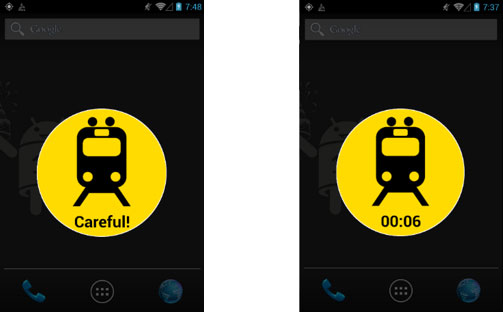The European project SAFER-LC identified innovative level crossing safety measures and piloted some of the most potential ones at eight pilot sites. The measures which were estimated to have the highest safety potential were ‘Additional lights on locomotive’ and ‘In-vehicle train and LC proximity warning’.
The European project SAFER-LC (Safer level crossing by integrating and optimising road-rail infrastructure management and design, https://safer-lc.eu/) aimed to improve safety and minimise risks at and around railway level crossings (LCs) by developing a fully integrated cross-modal set of innovative solutions and tools for the proactive management and new design of level crossing infrastructure. During the project 21 innovative level crossing safety measures were piloted at eight pilot sites in various environments and in different European countries. The pilot test sites varied from simulation studies to controlled conditions and real railway environments.
Estimation of safety effects
The safety effects were estimated via a two-step process. First, the share of relevant level crossing types where a measure would be applicable was defined together with the corresponding share of level crossing accidents (source: ERAIL database, 2019). Then, the effectiveness estimates (i.e. accident reduction potential) were collected based on pre-existing information on the effects of level crossing safety measures (e.g. Silla et al., 2015) and the results from the pilots conducted within the project. The final estimates on safety effects were formed by multiplying the effectiveness estimates with the share of relevant level crossing accidents.
It is acknowledged that many uncertainties are related to these estimates on safety effects. Several assumptions were made e.g. regarding the penetration rate (all relevant level crossings, trains and/or road users would be equipped with the system) and functionality and reliability of systems (100%). However, the assumptions used in the calculations are clearly documented and hence the estimates can be easily updated if more detailed statistics or more information on safety effects become available.
Promising safety effects of the piloted measures
Based on the safety potential calculations, the piloted measures that were estimated to have the highest safety potential were:
- ’Additional lights on locomotive (potential to prevent 6–30% of level crossing accidents): Installation of additional blinking lights on the locomotive to complement the regular triangular lights. The blinking lights activate when the train is arriving to a level crossing.
- In-vehicle train and level crossing proximity warning (potential to prevent 4–15% of level crossing accidents): System informing car drivers about the presence of an upcoming level crossing through a dedicated pop-up window and a short audio alert via an in-vehicle device. The warning also includes the estimated time of arrival whenever and incoming train is expected to reach the level crossing within one minute (Figure 1).
- Blinking lights drawing driver attention (potential to prevent 2–8% of level crossing accidents): Blinking lights positioned in the peripheral vicinity of a level crossing (left and right), which activate whenever a road user is approaching a level crossing. The lights support the visual scanning of tracks for potentially approaching trains at passive level crossings.
- Speed bumps and flashing posts (potential to prevent 2–8% of level crossing accidents): Installation of an array of speed bumps (150, 100 and 50 m) before a passive level crossing. To increase effectiveness, the bumps are coupled with red flashing posts (equipped with red LED lights).

Figure 1. Illustration of ‘In-vehicle LC and train proximity warning’ (Salanova et al., 2020). The static visual LC warning (left) and the dynamic warning when the train is estimated to reach the LC in six seconds (right).
Overall, the safety effect results of the piloted measures are promising. Therefore, it is recommended that some of most promising measures will be tested in larger scale real world experiments with well-planned experimental design to obtain more information on their effects (also long term) on road user behaviour and traffic safety. Future studies would also support more exact numerical estimates of the safety effects of the measures evaluated in the SAFER-LC project.
The SAFER-LC Toolbox
The experiences collected during the piloting and the evaluation results of each piloted safety measure are included in the SAFER-LC toolbox. This toolbox is the main output of the SAFER-LC project which integrates all the project results and solutions to help both rail and road stakeholders improve safety at LCs. The current toolbox includes information on 48 LC safety measures.
References:
ERAIL database. 2019. European Railway Accident Information Links. https://erail.era.europa.eu/safety-indicators.aspx. Accessed: August, 2019.
Salanova J.M., Boufidis N., Aifadopoulou G., Tzenos P. & Tolikas A. 2020. Multimodal Cooperative ITS Safety System at Level-Crossings. The 23rd IEEE International Conference on Intelligent Transportation Systems, Rhodes, Greece, September 20–23.
Silla, A., Seise, A. & Kallberg, V-P. 2015. Survey and assessment of measures aiming to improve the safety of LCs. Research reports of the Finnish transport Agency 7/2015.
Link to SAFER-LC Toolbox
SAFER-LC has received funding from the European Union’s Horizon 2020 research and innovation programme under grant agreement No 723205.
More detailed information on the evaluation of safety effects can be found here:
SAFER-LC (2019). Deliverable D4.4: Results of the evaluation of the pilot tests
 Contact:
Contact:
Anne Silla
anne.silla@vtt.fi
VTT Technical Research Centre of Finland Ltd., Finland






Follow us: